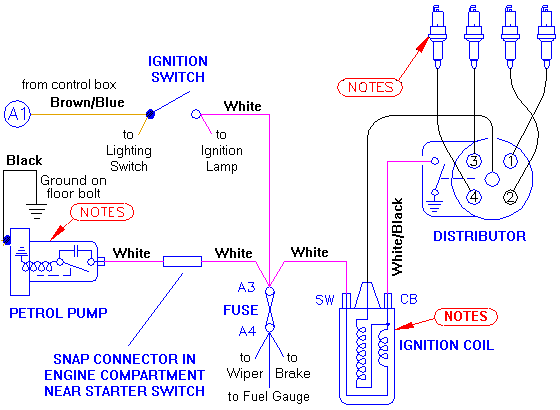The MGA With An Attitude
Fuel Pump ROAD FIX -- FP-102
For more than 50 years (maybe more like 70 years) people have known about reliability problems with SU electric fuel pumps. This article is not about arguments to the contrary, or alternate non-original fuel pumps. It is all about what people do to cope with a faulty SU fuel pump with it happens to them on road.
The single most common problem by far is bad contact in the electrical contact points preventing the fuel pump from running. Most (maybe all) MGA originally had "bare" or unprotected points in the fuel pump that were subject to electrical erosion or pitting in normal operation. Later cars and some replacement pumps had a condenser (capacitor) across the points to reduce arcing and erosion (but not eliminate it). Still later some pumps would have a diode across the points that would almost entirely quench any arcing. The diode units are polarity sensitive, so when changing electrical system polarity the diode needs to be reversed. Diodes can also blowout or short to ground if polarity is accidentally reversed even momentarily during installation or servicing. That has caused problems with replacement parts, especially for novice DIY mechanics. Some modern replacement units now have a metal oxide varistor (MOV) across the points that serves similar purpose to the diode but is not polarity sensitive. Any fuel pump with contact points is subject to corrosion of the contact points when not running, especially if parked without use for a while. Just leaving it unused for six months over winter layup might disable the pump until the points are cleaned or filed to restore electrical contact.
When the points type fuel pump will not run after extended storage, even a new one right out of the box, solution is to remove the plastic end cover and clean the contact points. In fact new fuel pumps commonly include a note advising to clean the points before installation. Most people catch on to this issue fairly quickly and will do this when retrieving the car from winter storage. This by itself is usually not enough to cause people to abandon the original type fuel pump.
Another cause of the SU points type fuel pump stopping is simple old age. When the flexible diaphragm in the pump head gets old it can also get stiff enough to resist full free motion. This may reduce travel of the parts enough to inhibit throw-over of the contact points mechanism. The ultimate solution then is to replace the diaphragm. But meanwhile the issue of intermittent failure of the pump at inopportune moments can be irritating (to put it mildly). A single incident of fuel pump failure on the road may be enough to have the driver spitting bullets.
The most common emergency "fix" for the reluctant fuel pump is to "whack it with a wrench" to get it running again. Sometimes this works for a while before the next failure. More often, especially if it has been ignored and "lived with" long enough to get worse, the single impact may only yield a single click of the pump. The emergency "fix" then is to continually whack the pump to get repeated clicks to keep the engine running. This might involve leaving the battery cover off (and convertible top up) so that driver or passenger might continue beating on the fuel pump while driving. Been there, done that. Sometimes it works well enough to get where you're going, but most often at a reduces speed due to limited fuel flow.
Other suggestions have been more bizarre, like open the fuel filler cap and blow hard into the tank to push fuel into the carburetor float chambers, then drive a short distance until the carbs go dry, and repeat the process. Someone once made a stop at a hardware store to buy some small hose and a large rubber stopper that fit the fuel filler port, enabling the passenger to continue to blow into the fuel tank while riding (would not recommend the driver doing this). Another person followed with a similar story adding a hand pumped garden sprayer to provide pressure for the fuel tank.
Another casual observation is that turning off the ignition switch momentarily and switching it back on can garner one click from the fuel pump. Doing this repeatedly may fill the carb float chambers, then allowing start up and a short drive until it runs dry again. This leads to the suggestion that continually flipping the ignition off and on may provide enough fuel flow to keep driving (probably at some reduced speed). One issue there is that momentary interruption of ignition spark and normal combustion in the engine can fill the exhaust system with the perfect mixture of fuel and air, so when ignition is restored there may be an explosion that could blow out the muffler (not to mention attracting undesired attention).
Offshoot of this leads to various ideas for regularly interrupting electrical power to the fuel pump without switching off the ignition. For instance, disconnect the power feed wire at the fuel pump and manually touch the wire to pump repeatedly (while driving). Now we're getting closer to my favorite suggestion.

 
|
Look at the electrical diagram above and the picture at right. Under the bonnet, find terminal A3 on the fuse box that holds three white wires. Disconnect the wire for the fuel pump. You know you have the right one disconnected when you still have power to the ignition coil. Connect the fuel pump power wire to the "L" terminal of the turn signal flasher unit nearby (Green/Brown), and drive on. It may not tick the fuel pump fast enough for high speed, but could be good for about 45 mph.
|

